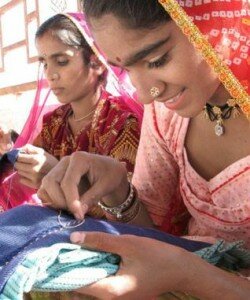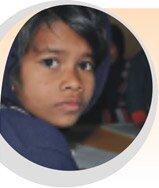Case Studies
Rangsutra: ‘The next leap of faith – strengthening the base in order to scale up significantly and successfully’
groups, work on a particular aspect of the production chain, so that each of Rangsutra’s final products is the result of the carefully coordinated efforts of these various groups. The artisans also have a strong ownership stake in the organization’s shareholding, a factor that consolidates and strengthens their position as entrepreneurs in their own right. Guiding these community-led initiatives, coordinating the efforts of the artisan groups, building their capacity as artisans/ entrepreneurial entities and providing them with essential market linkages is the essence of Rangsutra.
 In 2012, the social enterprise actively aimed to strengthen its supplier base of artisans in order to ‘scale up significantly and successfully’ in the region of Western Rajasthan, a significant effort that was catalyzed through the grant and capacity building support from the Development Marketplace (DM) program of the World Bank in 2011. This ‘next leap of faith’ aimed to address specific, intrinsic challenges of scale in the organization’s business model. The challenges included ensuring timely production, strengthening the supply chain, keeping up the quality while building capacity to scale, and building infrastructure to centralize operations. According to Rangsutra’s founder and Managing Director, Sumita Ghose, the organization is in a unique position, “We are somewhere between a start-up and a large-scale enterprise.” Through the 2011 India DM grant, Rangsutra decided to focus on strategic solutions that view scale particularly from the supplier base perspective. Increasing producer capacity, streamlining the processes of product sampling and finalization of orders to meet buyer expectations is especially important to the social enterprise’s growth; lack of capacity in these areas having previously led to delays and loss of orders.
In 2012, the social enterprise actively aimed to strengthen its supplier base of artisans in order to ‘scale up significantly and successfully’ in the region of Western Rajasthan, a significant effort that was catalyzed through the grant and capacity building support from the Development Marketplace (DM) program of the World Bank in 2011. This ‘next leap of faith’ aimed to address specific, intrinsic challenges of scale in the organization’s business model. The challenges included ensuring timely production, strengthening the supply chain, keeping up the quality while building capacity to scale, and building infrastructure to centralize operations. According to Rangsutra’s founder and Managing Director, Sumita Ghose, the organization is in a unique position, “We are somewhere between a start-up and a large-scale enterprise.” Through the 2011 India DM grant, Rangsutra decided to focus on strategic solutions that view scale particularly from the supplier base perspective. Increasing producer capacity, streamlining the processes of product sampling and finalization of orders to meet buyer expectations is especially important to the social enterprise’s growth; lack of capacity in these areas having previously led to delays and loss of orders.
Rangsutra soon realized that capacity building initiatives were therefore key to its strategies of scale and through the 2011 India DM, much of Rangsutra’s efforts in this area were mobilized. “After the DM, we had a very concentrated effort towards capacity building that we had not had before,” says Sumita. More than 150 to 200 artisans were reached through workshops that focused on new product development, monitoring and quality workshops. With close to 70% of shareholders being women, training had a gendered focus: a total of 1610 women artisans benefited from training in their villages. Field workshops were organized keeping in mind the traditional designs of the weavers as well as the present market demand. The enterprise’s ‘on the job – learning by doing’ approach also included capacity building initiatives for its staff members, imparting management and planning skills to persons managing crafts groups and improving efficiencies in areas such as order planning with managers, order scheduling and tracking. This capacity building had a significant positive impact for the artisan groups. Up to 2200 beneficiaries (producers incl. artisans) have also received work through the orders.
Rangsutra further strengthened its production base in certain key areas across its structure and functioning, an endeavor enabled, to a large extent, by the DM grant. In 2012, it incorporated 600 new artisans as shareholders of its stock to total 1800 artisan members, a 50% jump from its previous number of 1200. The social enterprise also increased the base of its artisans’ skills, introducing two new crafts to its repertoire and piloting them for future incorporation. Rangsutra’s inclusive business model aims to proactively involve community members and in this regard, it scaled along its production line by cultivating organic cotton for its own requirements. In partnership with local organizations in Bikaner, Rangsutra launched a pilot for organic farming on 35 bighas of land. The first crop from the cotton is due for harvest in April of 2013 and the project is planned to be scaled to 11 more villages following the pilot phase, benefiting close to 3000 small and medium farmers in these villages “We would not have been able to pilot this program without the addition of DM funds,” says Sumita.
 These initiatives to scale required the organization to also shift its thinking, essential to ensure the success of its efforts. “It added a global approach to our thoughts,” adds Sumita. Rangsutra also partnered with organizations such as Monsoon Accessorize Product Design to understand quality expectations of the export market, as well as collaborating with subject matter experts from Paris, for new product development in organic cotton. Artisans are actively pursuing natural dyes and organic cotton products in an endeavor to meet the demands of the burgeoning overseas market. As a winner of the DM grant, Rangsutra gained the kind of exposure that helped to place it as one of the leading social enterprises in the handicrafts sector. It also led to increased collaboration and knowledge sharing with other organizations.
These initiatives to scale required the organization to also shift its thinking, essential to ensure the success of its efforts. “It added a global approach to our thoughts,” adds Sumita. Rangsutra also partnered with organizations such as Monsoon Accessorize Product Design to understand quality expectations of the export market, as well as collaborating with subject matter experts from Paris, for new product development in organic cotton. Artisans are actively pursuing natural dyes and organic cotton products in an endeavor to meet the demands of the burgeoning overseas market. As a winner of the DM grant, Rangsutra gained the kind of exposure that helped to place it as one of the leading social enterprises in the handicrafts sector. It also led to increased collaboration and knowledge sharing with other organizations.
Rangsutra’s current approach has a very strong focus on its long-term sustainability, “We are now more tuned to the business aspect of our work that was very much needed,” says Sumita. Key to its future plans is the establishment of a centralized facility for design, sampling, learning and production coordination. Centralization would help to streamline much of its production processes, improving efficiency in the system. Therefore in 2012, Rangsutra began to actively mobilize plans for this facility, looking also to raise funds for its further growth and expansion.
A key learning for the social enterprise has been the importance of good human capital in improving efficiency, a limitation among many social enterprises. This must be strongly supported by understanding the nuances of a particular region. “What works best for one place many not work at all for another and proper knowledge of the area is important”, opines Sumita. Underpinning this is the importance of viewing scale from the perspective of the supplier base.
For Rangsutra, all these initiatives of growth boil down to one very important and perhaps, the most significant, measure of its success: the impact it makes within the communities in which it works. A lot of careful consideration has gone into determining the metric to measure this impact. “We decided that increase in income for the artisan was the best impact metric to use,” says Sumita. In the dry, hot regions of Western Rajasthan, on the outskirts of the Great Indian Desert, this strengthening of the economic security is crucial for families.





